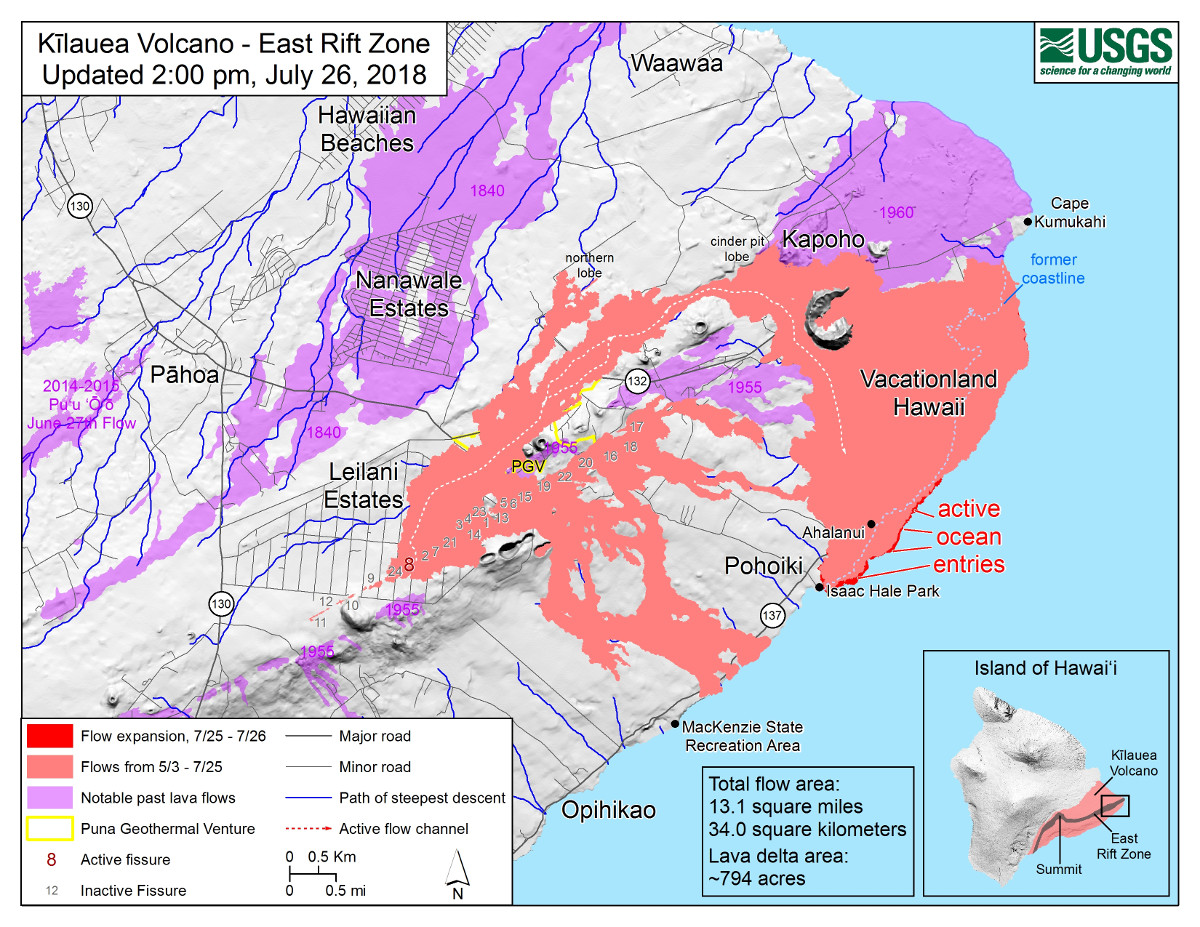
(USGS) As of 2:00 p.m. HST, July 26, 2018, the lava flow margins had not expanded since the previous map, so no red areas (indicating expansion) appear on this map. Given the dynamic nature of Kīlauea’s lower East Rift Zone eruption, with changing vent locations, fissures starting and stopping, and varying rates of lava effusion, map details shown here are accurate as of the date/time noted. Shaded purple areas indicate lava flows erupted in 1840, 1955, 1960, and 2014-2015.
(BIVN) – After the lengthiest interval between Kilauea summit collapse events since May (over 52 hours), another collapse struck at 12:09 p.m. today, right in the middle of the USGS / media conference call.
Before the collapse event occurred, one of the main topics of discussion was the prolonged period between events at the summit, which normally lasts from 30 to 35 hours. In addition, earlier this morning the USGS Hawaiian Volcano Observatory noted that “lava movement in the channel seemed sluggish through, and levels were lower in, the lower part of the channel” and the lava fountaining at the active Fissure 8 vent remained “relatively low.”
Following the summit collapse event this afternoon, the HVO field crews reported “fluctuations in the channel level with small overflows occurring in the upper portion of the channel”, according to Hawaii County Civil Defense. Also, “the western margin of the flow near Pohoiki has not advanced significantly westward so the flow remains approximately 500 feet from the Pohoiki boat ramp in Isaac Hale Park.”
Due to the relative stable nature of the current eruption on the lower East Rift Zone, the USGS will no longer hold pre-scheduled telephone news briefings.
In other news, the Hawaii Department of Human Services says food assistance is available to those affected by the eruption. In a recent media release, DHS said:
Short-term food assistance will soon be available for families affected by the East Hawai‘i Kilauea volcanic eruption through the Disaster Supplemental Nutrition Assistance Program (D-SNAP). The State of Hawai‘i Department of Human Services (DHS) will accept applications in Hilo and Kailua-Kona beginning Wednesday, July 25.
“East Hawai‘i residents face daily disruptions to their lives from the lava flow, and D-SNAP is another option for our teams on the ground to get community members the help they need. County, state and federal partners are continuing to work closely together to provide this important piece of relief,” said Governor David Ige.
D-SNAP benefits are typically available within 72 hours of approval, providing quick relief for families in need. These benefits, issued via an electronic benefits transfer (EBT) card, can be used to purchase food at grocery stores and other retailers that accept SNAP. Households who qualify may receive one month of benefits, equivalent to the maximum amount of benefits normally issued to a SNAP household of their size.
To apply for D-SNAP, visit application sites located at:
South Hilo Processing Center, 1990 Kinoole Street, Suite 109
West Hawaii Civic Center, 74-5044 Ane Keohokalole Highway, Kailua-Kona
Individuals and families may apply for D-SNAP from July 25, 2018 through August 2, 2018. DHS offices are open weekdays 7:45 a.m. to 4:30 p.m. and closed on Saturday and Sundays. DHS will provide D-SNAP signs at facilities to help residents quickly find the entrance and get assistance. Additional information about D-SNAP is available below. Residents may also get more information by calling (808) 981-2754.
According to the state, “DHS families impacted by the Kīlauea East Rift Zone event must have resided or worked in the following East Hawai‘i areas during the identified disaster period of May 3 – June 29” in order to be eligible:
• Leilani Estates;
• Lanipuna Gardens;
• Kapoho Vacationland;
• Kapoho Beach Lots;
• Highway 130 near Ala‘ili Road / Kamā‘ili Road;
• Highway 132;
• Noni Farms Road;
• Farm Lots / Farm Lots Kapoho;
• Papaya Farms Road;
• Wa‘a Wa‘a, and
• Nānāwale Estates.
DHS supplied this information on how to apply:
How to Apply:
Households impacted by the disaster can complete a simplified application. DHS also encourages households not normally eligible for traditional SNAP to apply. They may qualify for D-SNAP as a result of disaster-related expenses such as loss of income, damage to property, relocation expenses, and, in some cases, loss of food due to power outages. Applicants should be prepared to provide a photo I.D. or other proof of identification, proof of residence or employment in the disaster area described above, and information about income, resources and disaster expenses.Existing SNAP Clients:
Households currently participating in SNAP are not eligible to receive D-SNAP but may apply for supplemental benefits during the D-SNAP application period. SNAP households with disaster losses and whose SNAP benefits are less than the monthly maximum benefit can request to receive supplements to bring their SNAP benefits up to the maximum allotment for their household size.Fraud Penalties: Applicants must present their household circumstances correctly. Persons who purposely provide wrong information on a D-SNAP application will be denied benefits and legal action may be taken.
It is illegal to receive D-SNAP benefits twice for the same disaster. Households applying for D-SNAP more than once will be referred to fraud investigators for review.
All D-SNAP applications will be reviewed to ensure that their household is not participating in SNAP and that they have not already applied for and received D-SNAP benefits for this disaster.

by Big Island Video News5:15 pm
on at
STORY SUMMARY
HAWAII ISLAND - During the final regularly scheduled media conference call with scientists about the ongoing eruption of Kilauea, another collapse event struck the summit.